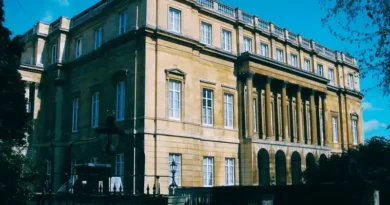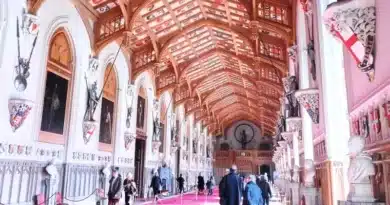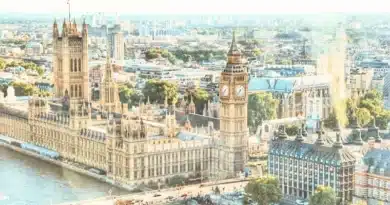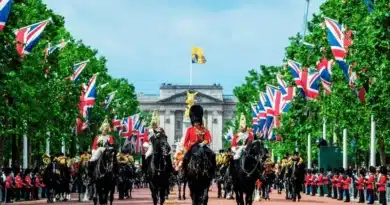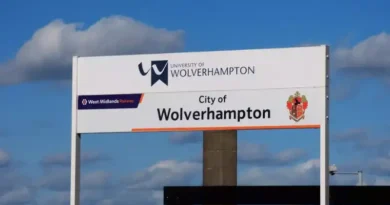Do Planes Fly Over Windsor Castle? In-depth Analysis
Planes do not fly directly over Windsor Castle due to a no-fly zone implemented for security reasons. This no-fly zone restricts aircraft from flying within 1.5 nautical miles around the castle and up to 2,500 feet above it. This measure, enforced by the Civil Aviation Authority (CAA) since January 2022, is part of ongoing security arrangements rather than a response to any specific threat (The Independent) (LBC).
However, it’s important to note that this restriction does not apply to aircraft travelling to or from Heathrow Airport under air traffic control, Royal Air Force aircraft, or those used by the royal family or emergency services (The Independent).
Key Takeaways
| Section | Key Takeaways |
|---|---|
| Introduction | Windsor Castle’s security is paramount, involving strict airspace regulations to protect the royal family and visitors. |
| Historical Context | Air travel over Windsor Castle has evolved, with significant changes post-WWII and the rise of commercial aviation. |
| Current Regulations | A no-fly zone prohibits aircraft within 1.5 nautical miles and up to 2,500 feet above the castle, monitored by advanced systems. |
| Reasons for No-Fly Zone | Security concerns, royal family protection, and public safety are the main reasons for the no-fly zone. |
| Exceptions | Exemptions include commercial flights to/from Heathrow, RAF aircraft, and emergency services, ensuring necessary operations continue. |
| Implementation | The CAA, Metropolitan Police, and Thames Valley Police enforce the no-fly zone using advanced technologies and strict penalties for violations. |
| Impact on Local Area | Despite security benefits, noise pollution from Heathrow affects local residents, prompting ongoing mitigation efforts. |
| Case Studies | Notable incidents include drone sightings and security breaches, leading to enhanced regulations and monitoring technologies. |
| Technological Measures | Advanced radar, UAV regulations, and future tech advancements strengthen airspace security over Windsor Castle. |
Let’s explore the details:
Introduction

Windsor Castle, an iconic British royal residence, is one of the most significant and historically rich landmarks in the United Kingdom. Located in Berkshire, this castle is a private home to the royal family and a site for state functions.
As the world’s oldest and largest inhabited castle, its protection is paramount. Central to this protection is regulating airspace above and around the castle, ensuring security for its inhabitants and visitors.
Historical Context

Historical Instances of Air Travel Over Windsor Castle
The history of air travel over Windsor Castle dates back to the early 20th century when aviation was still in its infancy. During World War II, the airspace became strategically important, and military flights were closely monitored to protect key sites, including Windsor Castle.
In the post-war era, the rise of commercial aviation, particularly with the development of Heathrow Airport nearby, brought increased air traffic to the area.
Initially, regulations were sparse and primarily focused on safe navigation. However, as aviation technology progressed and the volume of air traffic grew, it became clear that more stringent measures were necessary to protect such a prominent location.
Changes in Air Traffic Regulations Over Time
The regulation of air traffic over Windsor Castle has evolved significantly over the decades. In the late 20th century, more rigorous controls were introduced, driven by security concerns and the increasing air traffic density. Establishing the no-fly zone marked a significant shift in how airspace security was managed.
This no-fly zone, introduced in the early 21st century, resulted from comprehensive security reviews. These regulations have been periodically updated to incorporate technological advancements and address emerging threats, ensuring the continued safety of Windsor Castle and its occupants.
Current Regulations

Currently, Windsor Castle is protected by a well-defined no-fly zone. This zone restricts aircraft from flying within 1.5 nautical miles of the castle and up to 2,500 feet (1.5 nautical miles horizontally from the castle’s centre and 2,500 feet vertically. These measures are designed to prevent unauthorised aircraft from entering the airspace, mitigating potential security threats.
The no-fly zone is enforced continuously, reflecting the high priority placed on Windsor Castle’s security. It is part of a broader strategy to safeguard royal residences and other significant sites nationwide.
Any aircraft entering this airspace without proper authorisation is subject to immediate investigation and potential interception.
These specific boundaries are critical for maintaining a secure environment. The height restriction ensures that even high-flying aircraft do not pose a risk, adding an extra layer of protection.
Agencies Involved in Enforcing the No-Fly Zone
Multiple agencies are involved in enforcing the no-fly zone. The Civil Aviation Authority (CAA) plays a central role in establishing the regulations and overseeing compliance. The Metropolitan Police, particularly the Royal and Specialist Protection Command, are responsible for on-ground security.
Additionally, Thames Valley Police provide support, ensuring comprehensive security coverage. These agencies work together, utilising advanced technologies to monitor the airspace and respond swiftly to breaches.
Reasons for the No-Fly Zone

Security Concerns
The primary reason for the no-fly zone over Windsor Castle is security. The castle, serving as a royal residence and a site for significant state events, is a potential target for various threats. The no-fly zone helps prevent unauthorised aerial surveillance and potential attacks, safeguarding the castle and its inhabitants.
Protection of the Royal Family
Ensuring the safety of the royal family is paramount. The no-fly zone guarantees that the airspace above Windsor Castle remains clear of unauthorised aircraft, reducing the risk of airborne threats. This measure is especially crucial during high-profile events and when members of the royal family are present.
Public Safety Considerations
Public safety is another key consideration. Windsor Castle attracts millions of visitors annually. Restricting air traffic helps minimise the risk of accidents or security breaches that could endanger visitors. This approach maintains the castle as a secure and welcoming destination for tourists worldwide.
Exceptions to the No-Fly Zone

Commercial Flights to and from Heathrow Airport
Heathrow Airport, one of the busiest airports globally, is less than eight miles from Windsor Castle. Commercial flights to and from Heathrow can pass through the restricted airspace under strict control despite the no-fly zone. These flights follow designated paths managed by air traffic control, ensuring they do not threaten Windsor Castle.
Royal Air Force Aircraft
Royal Air Force (RAF) aircraft are exempt from the no-fly zone restrictions. These aircraft, involved in national security and defence operations, have clearance to navigate the airspace as necessary. This exemption ensures that the airspace regulations do not hinder essential defence activities.
Emergency Services and Royal Family Aircraft
Aircraft used by emergency services, including police, medical evacuation, and fire services, are also exempt from the no-fly zone. This exemption allows for rapid response to emergencies in or around Windsor Castle. Similarly, aircraft transporting members of the royal family have special clearance to operate within the restricted airspace, ensuring their mobility and safety.
Implementation and Enforcement

Role of the Civil Aviation Authority (CAA)
The Civil Aviation Authority (CAA) is pivotal in implementing the no-fly zone over Windsor Castle. As the UK’s aviation regulatory body, the CAA establishes airspace regulations and collaborates with other agencies to monitor compliance. Advanced radar systems track aircraft movements and detect any breaches.
Involvement of the Metropolitan Police and Thames Valley Police
The Metropolitan Police, specifically the Royal and Specialist Protection Command, oversee the immediate security of Windsor Castle. Thames Valley Police provide additional resources and personnel, ensuring comprehensive security coverage. Both forces are equipped to respond swiftly to any security incidents.
Monitoring and Penalties for Violations
Monitoring the no-fly zone involves sophisticated radar and surveillance technologies. Any unauthorised aircraft entering the restricted airspace triggers immediate alerts. Penalties for violations are severe, including fines and imprisonment for pilots found breaching the regulations. These strict penalties serve as a strong deterrent, reinforcing the importance of adhering to the airspace restrictions.
Impact on Local Area

Noise Pollution from Nearby Heathrow Airport
The proximity of Heathrow Airport to Windsor Castle has long been a source of noise pollution. Despite the no-fly zone, aircraft noise from planes approaching or departing Heathrow affects the local area, including Windsor. Efforts have been made to mitigate this impact through noise abatement procedures and carefully managed flight paths.
Public and Resident Feedback
Local residents have expressed varied opinions about the airspace regulations. While many appreciate the enhanced security, some are concerned about the noise pollution and the restrictions on air traffic. Authorities continue engaging with the community to address these concerns and improve the living environment.
Statements from the Royal Family
The royal family has occasionally commented on the airspace regulations. Queen Elizabeth II, for instance, has acknowledged the increased noise levels compared to the past but emphasised the necessity of these measures for ensuring security. Such statements highlight the balance between maintaining tranquillity and protecting Windsor Castle.
Case Studies and Incidents

Notable Incidents Involving Airspace Breaches
There have been several airspace breaches over Windsor Castle. In 2019, a drone was spotted flying near the castle, prompting a swift response from security forces. This incident highlighted the potential risks posed by drones and led to a review of the regulations.
Another notable incident occurred in December 2021 when a man carrying a crossbow was apprehended on the castle grounds. Although not directly related to airspace, this incident underscored the broader security challenges faced by Windsor Castle.
Security Reviews and Adjustments Post-Incident
Following significant incidents, comprehensive security reviews are conducted to assess and enhance protective measures. These reviews involve analysing breaches, identifying vulnerabilities, and implementing necessary adjustments. For example, after the drone incident, additional restrictions on UAVs were introduced, and monitoring technologies were upgraded.
Technological Measures

Surveillance and Monitoring Technologies
The enforcement of the no-fly zone relies heavily on advanced surveillance and monitoring technologies. Radar systems provide real-time tracking of all aircraft movements within the restricted airspace. These systems can quickly detect unauthorised entries, enabling security forces to respond promptly.
Drones and Unmanned Aerial Vehicles (UAVs) Regulations
The rise of drones and UAVs has introduced new challenges to airspace security. Specific regulations have been implemented to address these challenges, including mandatory registration for drone operators and strict no-fly zones for drones around sensitive areas like Windsor Castle. These regulations help prevent unauthorised drone flights and enhance overall security.
Future Advancements in Airspace Security
The field of airspace security is continually evolving. Future advancements may include more sophisticated monitoring technologies, improved UAV detection systems, and enhanced coordination between security agencies. These developments will strengthen the protective measures, ensuring Windsor Castle remains secure against emerging threats.
Comparative Analysis
Airspace Security Measures at Other Royal Residences
Other royal residences, such as Buckingham Palace and Balmoral Castle, also have stringent airspace security measures. These measures are tailored to each residence’s specific needs and threats, reflecting a comprehensive approach to royal security.
International Examples of Similar No-Fly Zones
Many countries have implemented no-fly zones around critical infrastructure and high-profile locations internationally. For example, the White House in the United States and the Kremlin in Russia have well-established no-fly zones. These international examples underscore the importance of such measures in protecting key national assets and figures.
Conclusion
The no-fly zone over Windsor Castle is an essential security measure that protects one of the United Kingdom’s most treasured landmarks. This regulation ensures the safety of the royal family, visitors, and the surrounding community.
It reflects a comprehensive approach involving multiple agencies, advanced technologies, and stringent enforcement mechanisms. While challenges include noise pollution from nearby Heathrow Airport and evolving threats like drones, continuous advancements and community engagement help maintain a balanced and secure environment.
The implementation of similar no-fly zones internationally underscores the universal importance of protecting critical infrastructure and high-profile locations from aerial threats.
FAQ
Why don’t planes fly over Windsor Castle?
Planes avoid flying directly over Windsor Castle because it is protected by a no-fly zone (RA1) implemented for security, privacy, and heritage preservation. This restriction helps prevent potential threats and disturbances and ensures a peaceful environment for the royal family and visitors.
What is the no-fly zone around Windsor Castle?
The no-fly zone, known as RA1, covers a radius of 2.5 nautical miles and extends up to 2,500 feet above ground level. Established in 2003, it ensures the safety of Windsor Castle from aerial intrusions, safeguarding its status as a royal residence and historic landmark.
Can private planes fly near Windsor Castle?
Private planes must strictly adhere to the RA1 no-fly zone rules. While they can operate in areas surrounding the restricted zone, they are prohibited from entering it unless granted special permissions for emergencies or official events, ensuring minimal risk to security and privacy.
How do flight paths near Windsor Castle impact Heathrow Airport?
Heathrow Airport, located roughly 8 miles from Windsor Castle, has carefully designed flight paths to avoid the RA1 zone. Pilots must navigate around Windsor’s restricted airspace during takeoff and landing, ensuring smooth operations while maintaining compliance with aviation regulations.
Are drones allowed to fly over Windsor Castle?
Drones are strictly prohibited from flying over Windsor Castle due to the RA1 no-fly zone. This rule applies to recreational and commercial drones, ensuring protection against potential security breaches, noise disturbances, and threats to the royal family’s privacy.
Have there been violations of the Windsor Castle no-fly zone?
Violations of the no-fly zone are rare but have occurred, typically due to errors by private pilots or unregistered drone operators. Such breaches are taken seriously and investigated thoroughly, often resulting in penalties or legal actions to maintain the integrity of the restricted airspace.
Why is Windsor Castle’s no-fly zone permanent?
Windsor Castle’s no-fly zone is permanent to protect one of the UK’s most iconic royal residences. The restriction ensures safety from potential air threats, preserves the dignity of the royal family, and provides a serene environment for both the residents and millions of visitors annually.
Do military planes fly over Windsor Castle?
Military planes generally avoid flying over Windsor Castle unless authorised for special occasions such as ceremonial flypasts or state events. These flights are pre-approved, carefully coordinated, and executed with stringent safety measures to respect the airspace restrictions.
How is the Windsor Castle no-fly zone enforced?
Air traffic control and aviation authorities monitor the no-fly zone using radar and surveillance systems. Any violations trigger immediate responses, including fines, legal consequences, or interception by military aircraft to ensure compliance and public safety.
What happens during ceremonial flypasts over Windsor Castle?
Ceremonial flypasts, such as those during royal celebrations or national events, are rare exceptions to the no-fly zone. These flights are meticulously planned in advance, coordinating with the military, aviation authorities, and event organisers to ensure they proceed safely and without disrupting regular air traffic.
References and Further Reading
- Civil Aviation Authority (CAA) official website: caa.co.uk
- Metropolitan Police reports on airspace security
- Statements from the royal family on airspace regulations
- Case studies on airspace breaches and security reviews
- Comparative studies on international no-fly zones and their implementations




